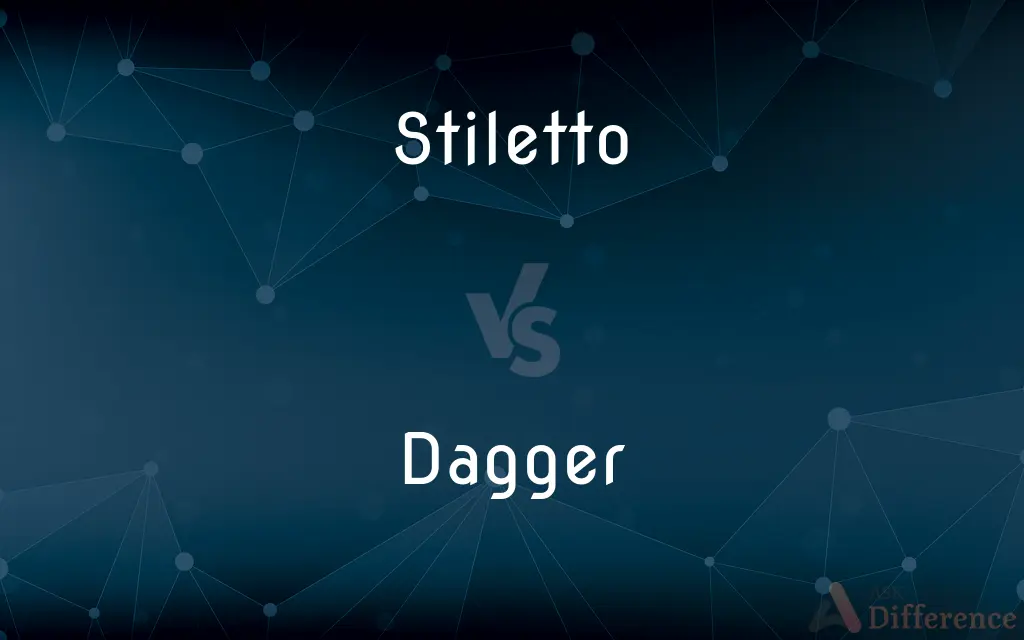Stiletto vs. Dagger — What's the Difference?
Edited by Tayyaba Rehman — By Maham Liaqat — Updated on April 26, 2024
Stilettos are slender, stabbing knives with long, narrow blades, primarily designed for thrusting; daggers, however, are typically double-edged, designed for stabbing and cutting, offering versatility in combat and utility.

Difference Between Stiletto and Dagger
Table of Contents
ADVERTISEMENT
Key Differences
Stilettos are characterized by their very slender, needle-like blades, which make them particularly effective for deep penetration and stabbing through thick clothing or armor. Whereas daggers feature a pointed, double-edged blade that can be used for both stabbing and slashing, making them more versatile in different combat situations.
The design of a stiletto minimizes the blade width to enhance its ability to inflict deep wounds that are difficult to stitch up, primarily used in concealment and surprise attacks. On the other hand, the broader blade of a dagger not only allows for effective stabbing but also enables slashing motions, useful in both self-defense and close combat scenarios.
Stilettos were popular among assassins and were often hidden on the body due to their slim profile. In contrast, daggers have been used openly in various cultures for combat, rituals, and as symbols of power.
The grip of a stiletto is usually straight and simple, designed to facilitate a quick stabbing motion. Busters, with their broader handles, often incorporate crossguards, which protect the user’s hand during fights.
In terms of cultural significance, stilettos have often been associated with stealth and secrecy, sometimes considered weapons of treachery. Daggers, however, have been portrayed more honorably in historical and mythical narratives, symbolizing bravery and sacrifice.
ADVERTISEMENT
Comparison Chart
Blade Shape
Long, thin, and needle-like
Shorter, double-edged, and pointed
Primary Use
Stabbing, penetrating
Stabbing and slashing
Blade Edges
Single-edged or edgeless
Double-edged
Handle Design
Straight and often lacks a crossguard
Often includes a crossguard for protection
Cultural Association
Associated with stealth and secrecy
Often seen as a symbol of power and bravery
Compare with Definitions
Stiletto
Known for its pointed tip and narrow construction.
The stiletto was hidden easily under his jacket.
Dagger
Can be a symbol of power and authority in many traditions.
The king’s dagger represented his right to rule.
Stiletto
Often used covertly due to its easy concealment.
The spy used a stiletto to silently neutralize the guard.
Dagger
Used historically across various cultures as weapons and ceremonial objects.
The ceremonial dagger was adorned with jewels.
Stiletto
Historically favored by assassins for its effectiveness in piercing armor.
Medieval stilettos were feared for their deadly precision.
Dagger
Features a sharp point and edges for combat versatility.
The dagger was essential for both defense and attack.
Stiletto
A knife with a long, slender blade primarily used for stabbing.
He carried a stiletto in his boot for protection.
Dagger
Often includes a protective hilt to guard the user’s hand.
His dagger’s ornate hilt was as functional as it was decorative.
Stiletto
In modern usage, sometimes referred to thin, pointed tools resembling the knife.
The sculptor used a stiletto to detail the clay model.
Dagger
A short, double-edged knife used for stabbing and cutting.
The warrior wielded a dagger alongside his sword.
Stiletto
A stiletto (Italian: [stiˈletto]) is a knife or dagger with a long slender blade and needle-like point, primarily intended as a stabbing weapon.The stiletto blade's narrow cross-section and acuminated (tapering gradually to a sharp point) tip reduce friction upon entry, allowing the blade to penetrate deeply. Some consider the stiletto a form of dagger, but most stilettos are specialized thrusting weapons not designed for cutting or slashing, even with edged examples.Over time, the term stiletto has been used as a general descriptive term for a variety of knife blades exhibiting a narrow blade with minimal cutting surfaces and a needle-like point, such as the U.S. V-42 stiletto, while in American English usage, the name stiletto can also refer to a switchblade knife with a stiletto- or bayonet-type blade design.
Dagger
A dagger is a knife with a very sharp point and usually two sharp edges, typically designed or capable of being used as a thrusting or stabbing weapon. Daggers have been used throughout human history for close combat confrontations, and many cultures have used adorned daggers in ritual and ceremonial contexts.
Stiletto
A small dagger with a slender, tapering blade.
Dagger
A short knife with a pointed and edged blade, used as a weapon
He drew his dagger and stabbed the leader
Stiletto
Something shaped like such a dagger.
Dagger
A moth with a dark dagger-shaped marking on the forewing.
Stiletto
A small, sharp-pointed instrument used for making eyelet holes in needlework.
Dagger
A short pointed weapon with sharp edges.
Stiletto
A shoe or boot with a stiletto heel.
Dagger
Something that agonizes, torments, or wounds.
Stiletto
A small, slender knife or dagger-like weapon intended for stabbing.
Dagger
See obelisk.
Stiletto
A rapier.
Dagger
A double dagger.
Stiletto
An awl.
Dagger
(weapons) A stabbing weapon, similar to a sword but with a short, double-edged blade.
Stiletto
A woman's shoe with a tall, slender heel (called a stiletto heel).
Dagger
(typography) The text character †; the obelus.
Stiletto
A beard trimmed into a pointed form.
Dagger
A point scored near the end of the game (clutch time) to take or increase the scorer's team lead, so that they are likely to win.
Curry's last-minute 3-point dagger silenced the criticism for his so-called failure to come up big in big moments.
Stiletto
(transitive) To attack or kill with a stiletto dagger.
Dagger
A timber placed diagonally in a ship's frame.
Stiletto
A kind of dagger with a slender, rounded, and pointed blade.
Dagger
To pierce with a dagger; to stab.
Stiletto
A pointed instrument for making eyelet holes in embroidery.
Dagger
A short weapon used for stabbing. This is the general term: cf. Poniard, Stiletto, Bowie knife, Dirk, Misericorde, Anlace.
Stiletto
A beard trimmed into a pointed form.
The very quack of fashions, the very he thatWears a stiletto on his chin.
Dagger
A mark of reference in the form of a dagger [
Stiletto
To stab or kill with a stiletto.
Dagger
A timber placed diagonally in a ship's frame.
Stiletto
A small dagger with a tapered blade
Dagger
To pierce with a dagger; to stab.
Dagger
A short knife with a pointed blade used for piercing or stabbing
Dagger
A character used in printing to indicate a cross reference or footnote
Common Curiosities
What historical roles have daggers played?
Daggers have been used in battle, ritualistic functions, and as symbols of power.
What is the primary design purpose of a stiletto?
The stiletto is designed mainly for thrusting and piercing.
Do all daggers have a crossguard?
Most traditional daggers have a crossguard to protect the hand, but designs can vary.
How is a dagger different in use from a stiletto?
A dagger is used for both stabbing and cutting, thanks to its double-edged blade.
Could a stiletto be dual-edged?
Traditionally, stilettos are single-edged or edgeless, focusing on piercing ability.
Are daggers still used today?
While not common in modern combat, daggers are still used ceremonially and collected as antiques.
Why is a stiletto considered a weapon of stealth?
Its slim, concealable design makes it ideal for secretive operations.
Can a stiletto be used for cutting?
Typically, stilettos are not effective for cutting due to their thin, sometimes edgeless blades.
How effective is a stiletto against armor?
Stilettos were historically used to penetrate chain mail or get into the gaps of armor.
What are common materials used in dagger blades?
Dagger blades are typically made of steel or other metals.
Is there a cultural significance to stilettos in any societies?
Stilettos are often seen in a negative light due to their associations with assassinations.
What is the typical length of a stiletto blade?
Stiletto blades can vary but are generally longer and thinner than dagger blades.
How are daggers presented in mythology?
In many myths, daggers are heroic symbols or magical artifacts.
Are stilettos legal to carry?
Laws vary by location, but stilettos are often restricted due to their association with concealed weapons.
What is the significance of the hilt designs on daggers?
Hilt designs can signify rank, affiliation, or artistic expression, adding to the dagger’s value and symbolism.
Share Your Discovery

Previous Comparison
Dog vs. Girl
Next Comparison
Pastiche vs. ParodyAuthor Spotlight
Written by
Maham LiaqatEdited by
Tayyaba RehmanTayyaba Rehman is a distinguished writer, currently serving as a primary contributor to askdifference.com. As a researcher in semantics and etymology, Tayyaba's passion for the complexity of languages and their distinctions has found a perfect home on the platform. Tayyaba delves into the intricacies of language, distinguishing between commonly confused words and phrases, thereby providing clarity for readers worldwide.















































